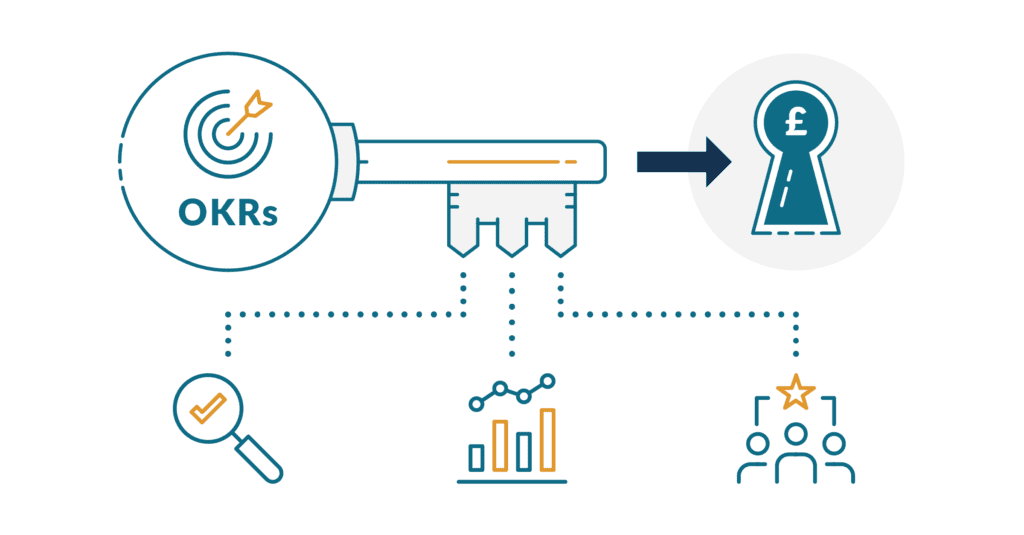Three ways OKRs can unlock the value of Agile
From working with iterative delivery methods for over twenty years, I am a passionate advocate of delivering little and often and seeking regular feedback from your customer. This agility in approach allows many benefits to be realised that include improved speed to market, creating products and services that customers love, reduced risk and increased employee engagement.
Agile methods bring us velocity, predictability and customer-centricity. Many leaders shared their joy at the shift they could see and feel in their teams and people, but especially as time has moved on, they started to share some challenges with me:
“I know our agile teams are churning out work faster than ever before, but we are just not clear on what the teams are delivering and how it contributes to strategy and everyone is complaining of competing priorities.”
“We can’t see the red thread between what our teams are delivering and our strategy.“
“We’re trying to transition to a Product Operating Model, but how do we organise cross-product to deliver on wider strategy?“
This sentiment was also echoed by people in the teams:
“I know what I am working on this sprint and how this contributes to the team, but not sure how it connects to the bigger picture?”
It has become increasingly difficult for leaders and team members alike to articulate how delivery is contributing to organisational strategy. And even harder to describe relevant, quantifiable benefits from the same work to ensure that investment is resulting in the intended return.
OKRs (Objectives and Key Results) are a widely used goal-setting methodology experiencing a resurgence in popularity as more and more organisations grapple with the challenge of bridging the Strategy Gap.
When I started to integrate Objectives and Key Results (OKRs) into agility frameworks, I realised this was a simple but very powerful way key to unlock even greater benefits from iterative agile methods.
How can OKRs help to do this?

Strategic Focus & Radical Prioritisation
Agile teams are empowered to define their own work and working with the Product Owner to order their team backlog. However, a study by Harvard Business School [1] found that a staggering 95% of employees do not understand their company’s strategy. So how are Product Owners and teams able to prioritise and deliver effectively if lacking an understanding on what their organisation is trying to achieve?
Within the OKR framework, an Objective is a qualitative, ambitious goal directly aligned to the strategic intent of the organisation. Key Results are then carefully constructed to identify how the team and organisation can measure that the goal has been achieved. OKRs are typically set annually and/or quarterly.
Some common challenges for agile teams are overloaded backlogs and creating the time, discipline and focus for regular backlog prioritisation is difficult. With a small number of clear, catchy quarterly OKRs, it allows Product Owners, managers and agile teams to quickly and easily sense-check if work is contributing to strategic commitments in backlog refinement sessions and iteration planning meetings. Memorable strategic objectives that are front of mind can bring radical focus [2] and allow teams to confidently slice through conflicting priorities and pet projects and prioritise the work that matters most.
Measuring Return on Investment
The Agile Manifesto and underlying principles promote working software as the primary measure of progress. Scrum defines continuous improvement, value delivery, and customer satisfaction as indicators of success, with the sentiment that these qualitative evaluations bring a greater richness than a set of metrics.
However today’s reality is that most organisations operate on quantitative, financially-driven success criteria, especially in relation to strategic investment. This can cause a gap in understanding about whether spend on key initiatives is generating expected returns. Quantifiable key results, in addition to qualitative customer feedback can help bridge this gap.
Reaching for the Stars
Agile methods sensibly guide teams to work within their available time and capacity. A mature Agile team may be described as one that has predictable velocity – the team completes a consistent amount of work when expected. Over time, due to the longstanding nature of agile teams, a shared understanding is created when estimating work effort. This predictability reduces delivery risk and also improves team morale – everyone loves to hit their targets!
In the pursuit of predictability, moon shots are generally avoided. Stretch goals are used by some teams but these can tend to be in realm of tactically trying to squeeze more into an iteration.
Goal-setting research [3] across a range of high-performance domains has repeatedly proven than people achieve far more with lofty and difficult goals, provided attainable short-term objectives are set along the way. Using a challenging long-term OKR that sits above short-term iteration objectives allows teams to set their sights high. This can improve performance and drive teams to deliver even more value, whilst allowing teams to still maintain the benefits of predictable velocity per iteration.
In our next article on OKRs and Agile, we will discuss some common pitfalls we see when integrating these ways of working and how to avoid them. FOLLOW JCURV ON LINKED IN
Author: Sarah Foxton. Managing Director at JCURV.
In today’s world of competing pulls and priorities, I enjoy working with organisations, teams and people to achieve what really matters to them, by simplifying strategy, improving agility and using research-based high-performance coaching methods.
[1] Kaplan, R. S., & Norton, D. P. (2005). The office of strategy management. Harvard business review, 83(10), 72. https://hbr.org/2005/10/the-office-of-strategy-management
[2] Wodtke, C. (2016). Radical focus: Achieving your most important goals with objectives and key results.
[3] Locke, E. A. & Latham, G. P. (1990). A theory of goal-setting and task performance. Prentice-Hall, Inc.
